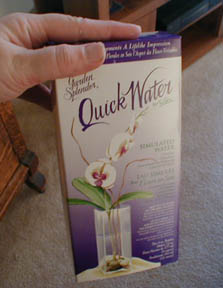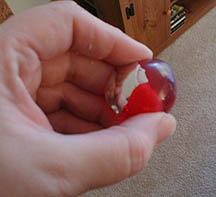

Home / Sculpting / Making a Mold / Casting / Painting / Gem Making Tutorial / Links / Contact Me

In my quest to find a clearer resin for gem-casting, I stumbled upon this stuff. Guaranteed to harden clear and to not yellow over time. And it all came in a self-contained kit with chemicals that mixed together in a 1 to 1 ratio. It sounded great.
It mixed together in much the same manner as the Pour-On resin had done. (So I'll spare you pictures of the mixing and pouring process.) I poured the blended compound into the latex mold for my wolf ornament and by the next day, it had hardened perfectly clear. I then proceeded to remove it...

Uh-oh. It did NOT harden into a solid resin, but rather, a clear, rubbery gel. (Perfect for it's intended use - to simulate water and hold flower stems in a rigid container - but alas, not perfect for casting hard resin objects.) What's worse, it crumbled as I removed it AND it stuck to the inside surface of my latex mold, completely destroying it.

Alas my attempts to create gemstones using Quickwater had fared no better. (I had some of the mixture leftover from pouring the latex wolf mold, so I dyed it and poured it into a gem-shaped mold that I had made from a cut-in-half plastic Christmas ornament.)

Well, I was able to remove the gemstone from the mold (although I had to crack and peel the plastic away from the surface of the gem like an eggshell.) The gem itself was clear but, alas, rubbery.
Bottom line: Quickwater should NOT be used as a substiture for casting resin. Nor should any other type of "simulated water" project, I imagine. (I guess if I want to find the perfect easy-mix hard clear gem-casting resin, I'll just have to keep looking...)
Next section: Finishing and Painting...
